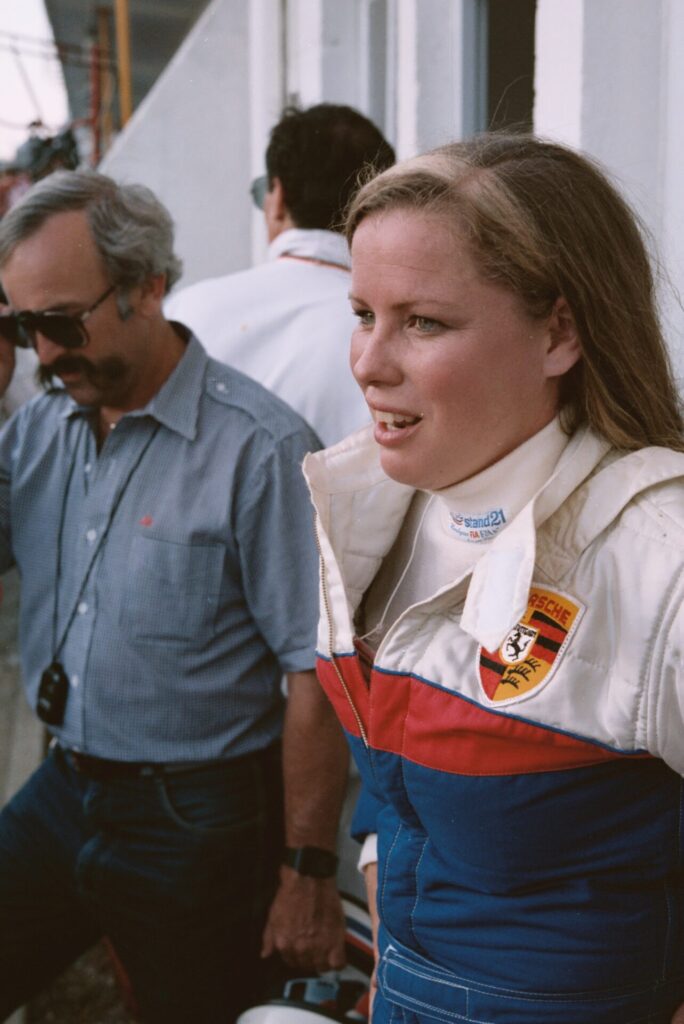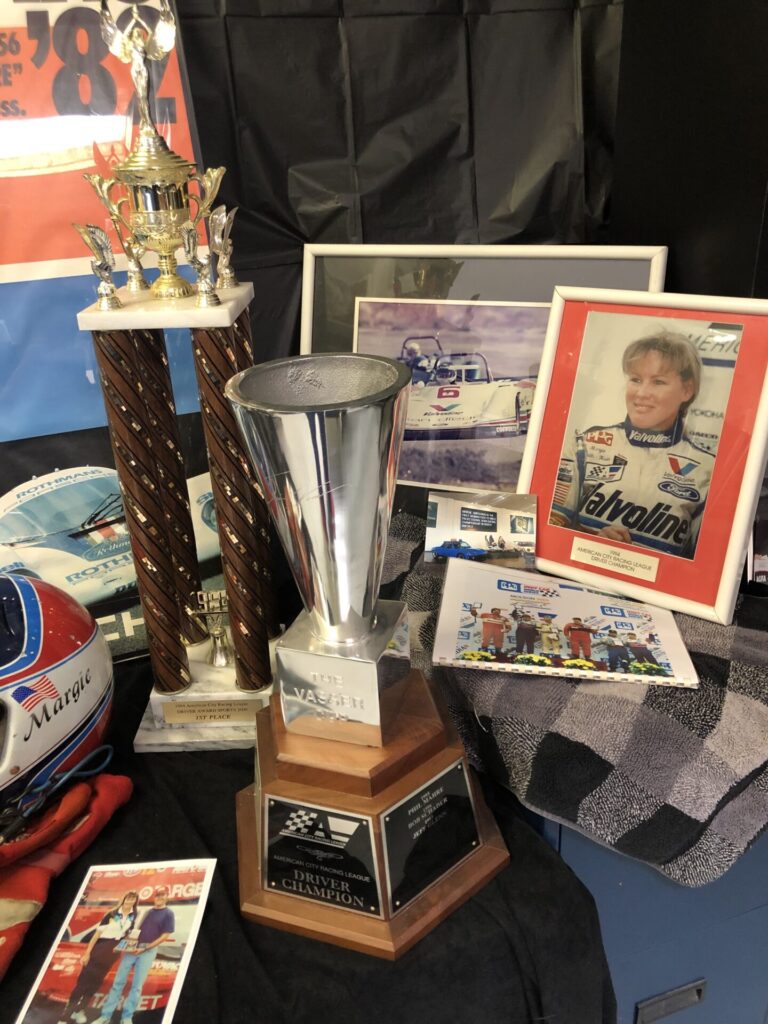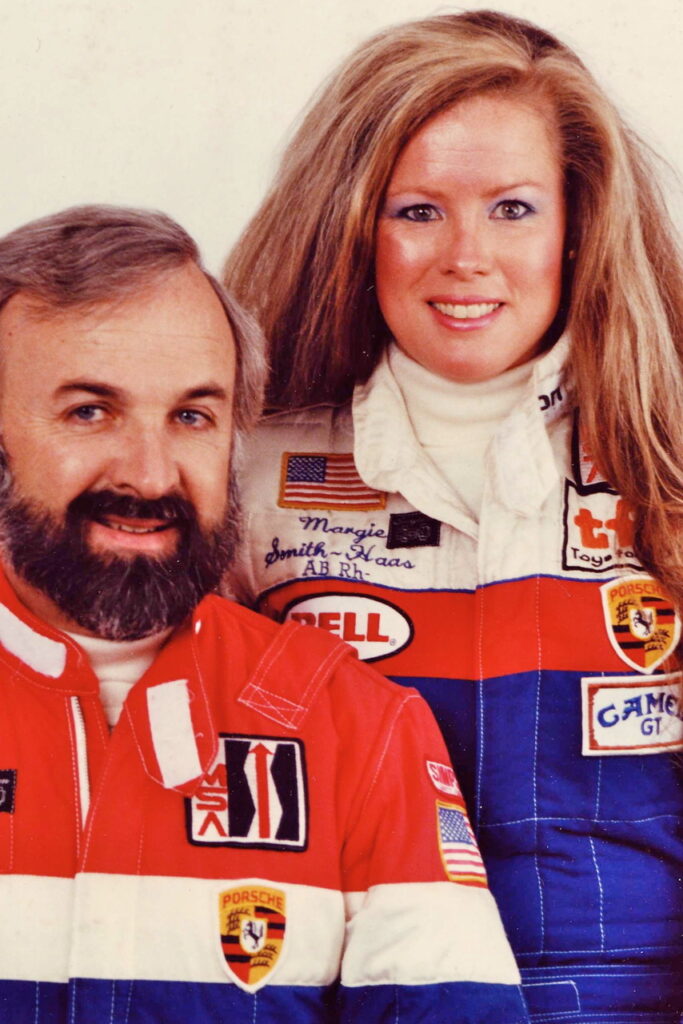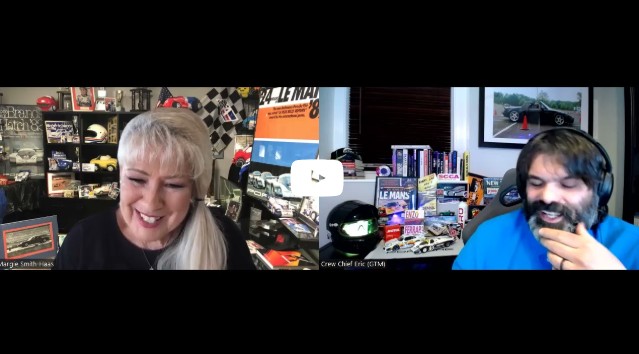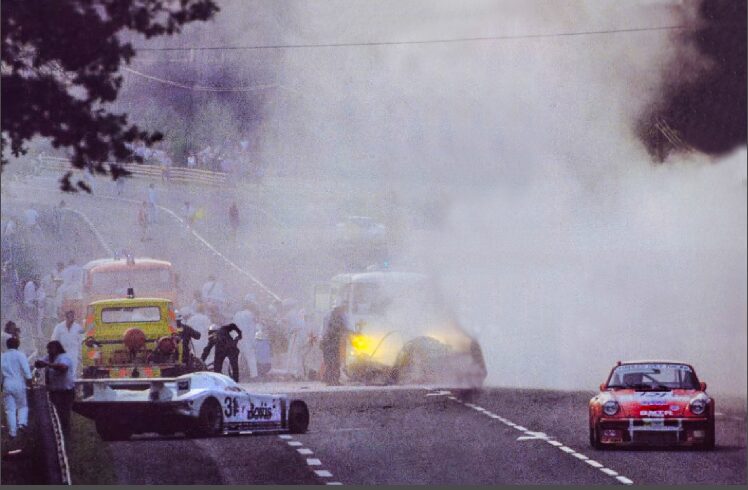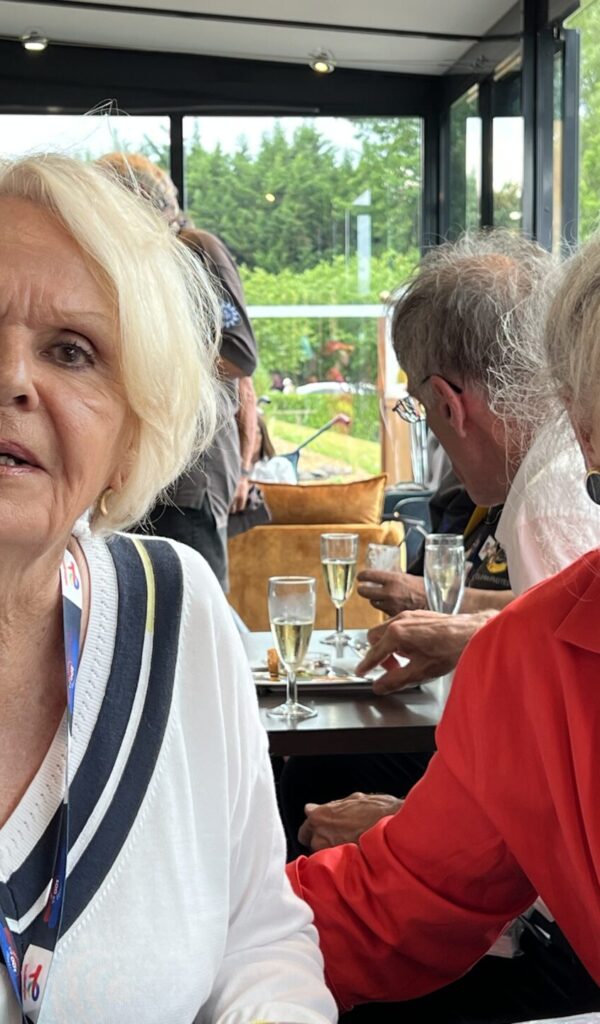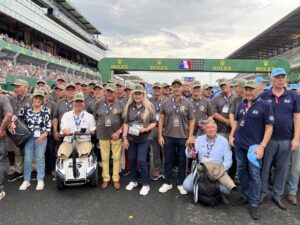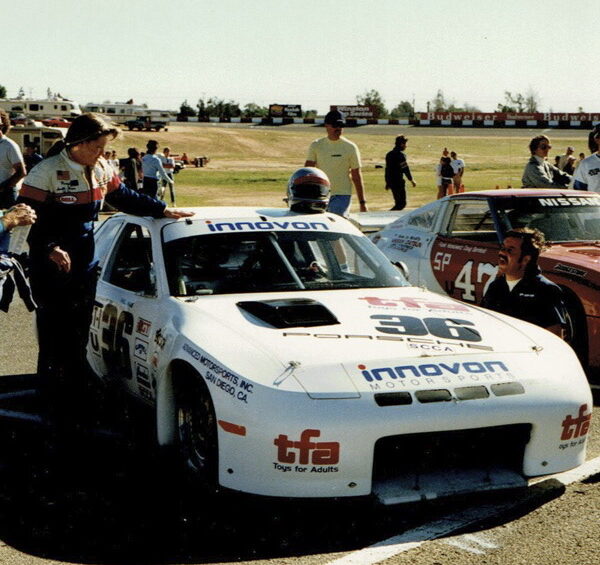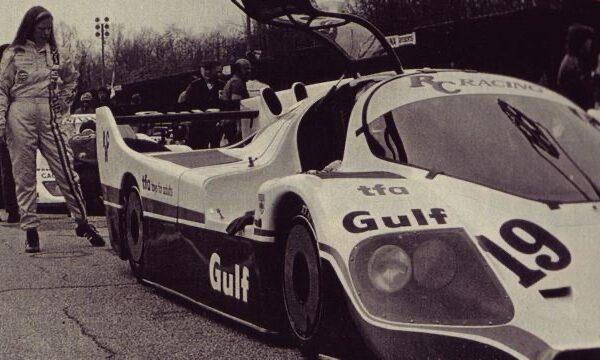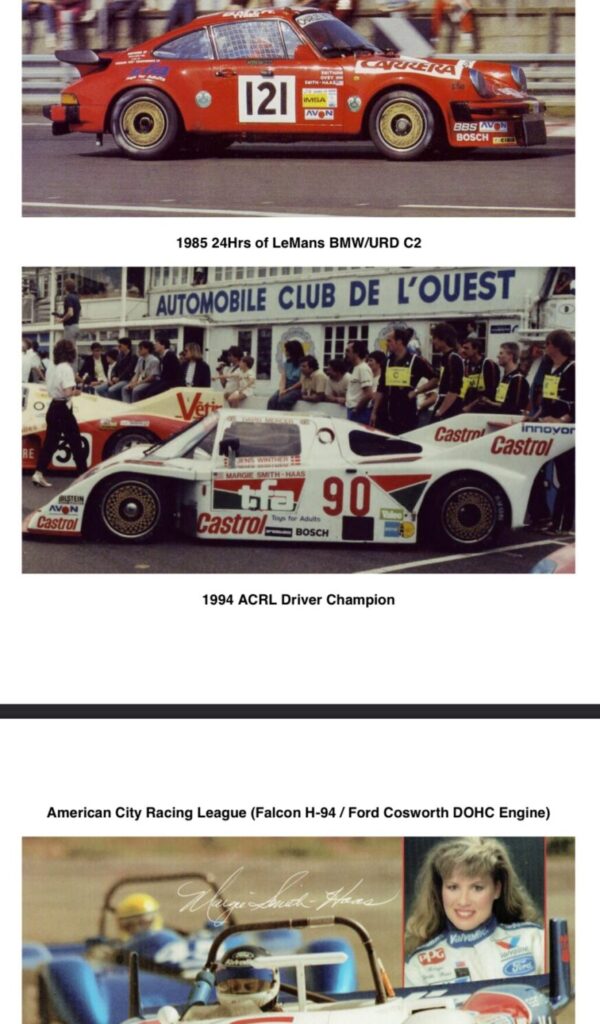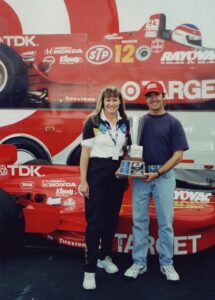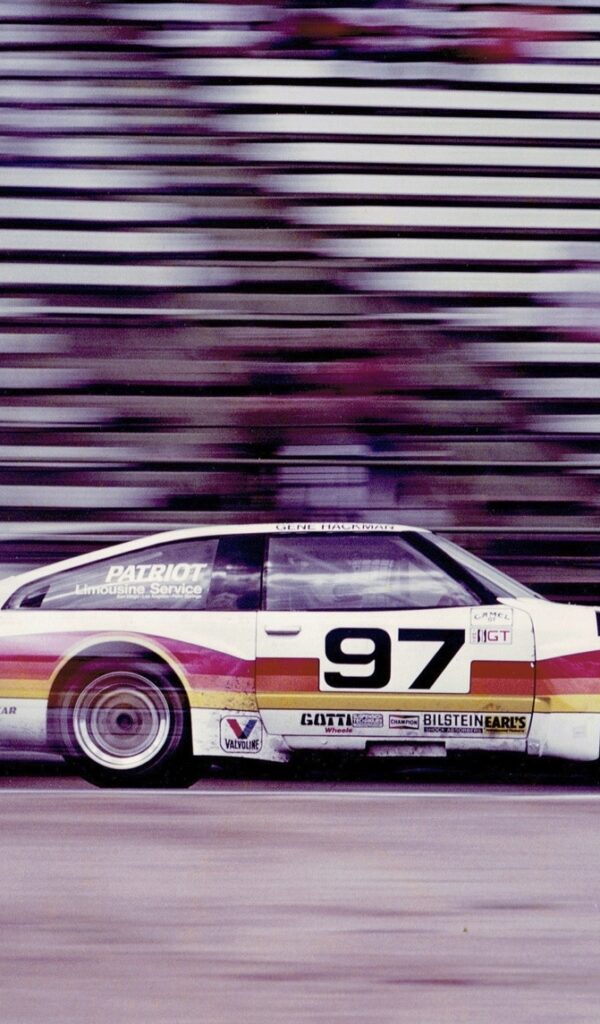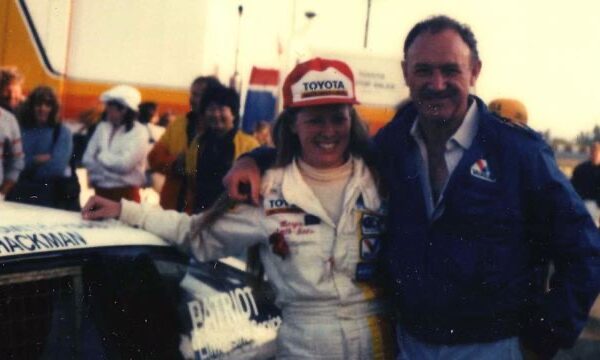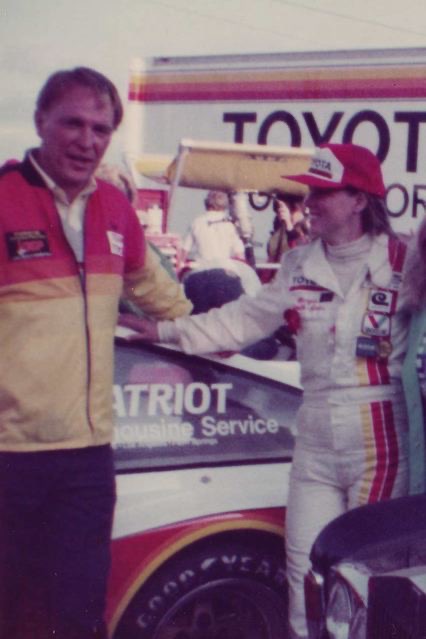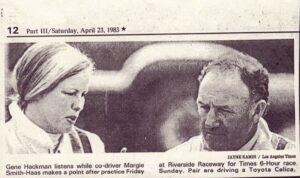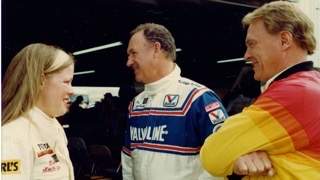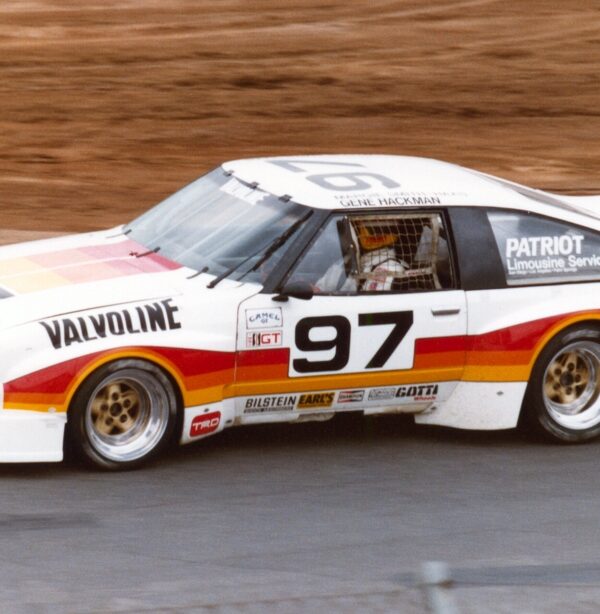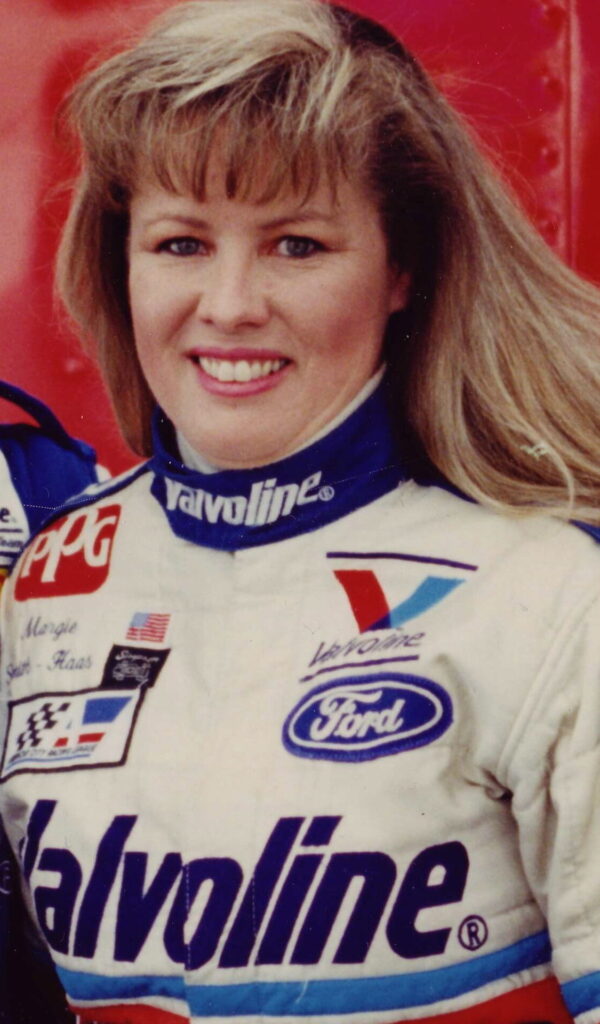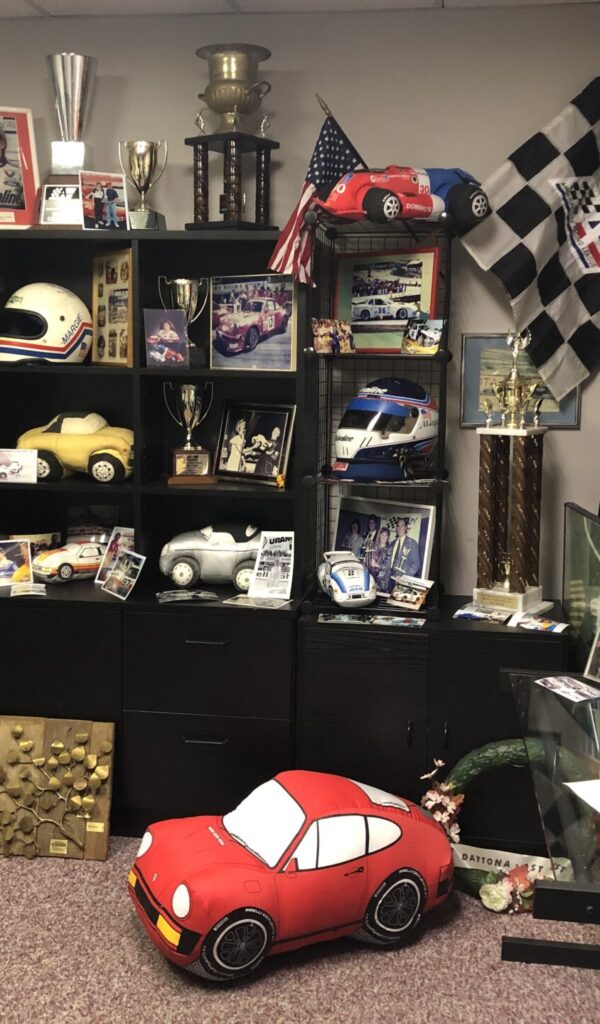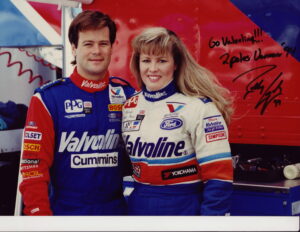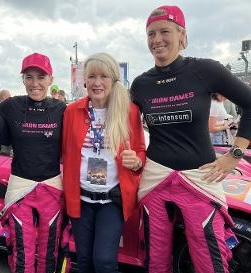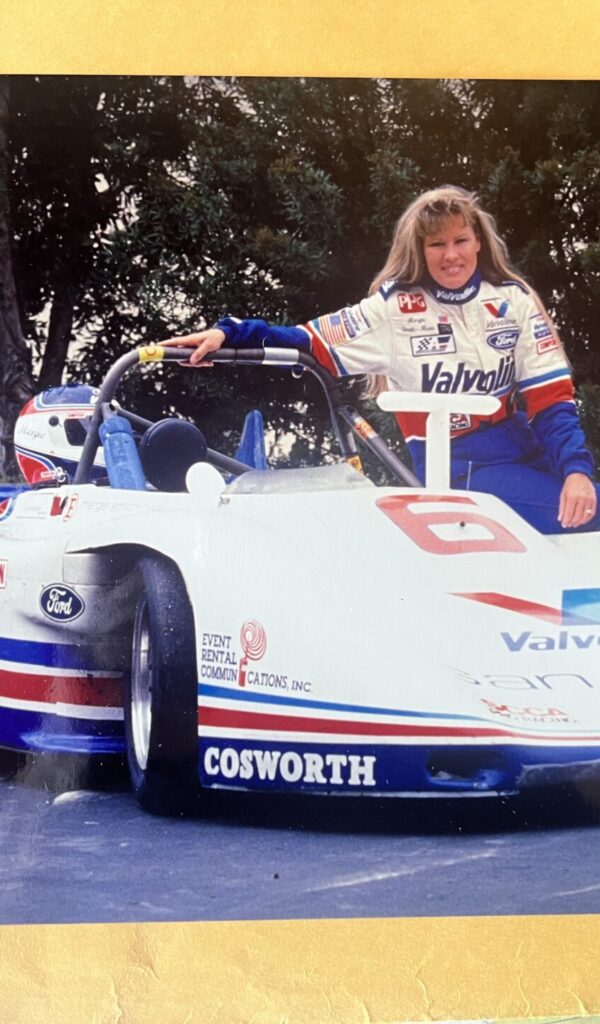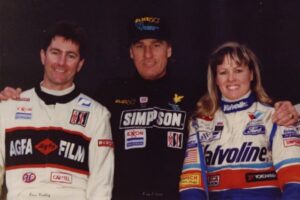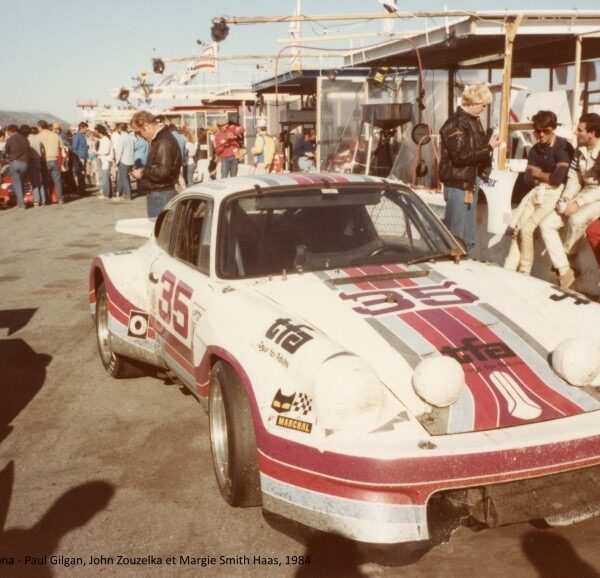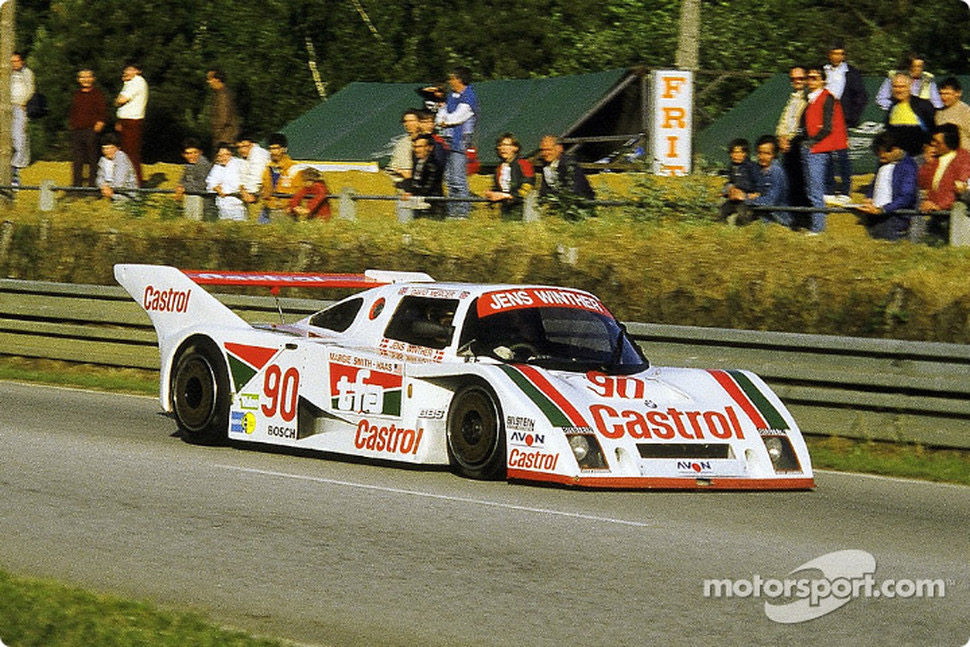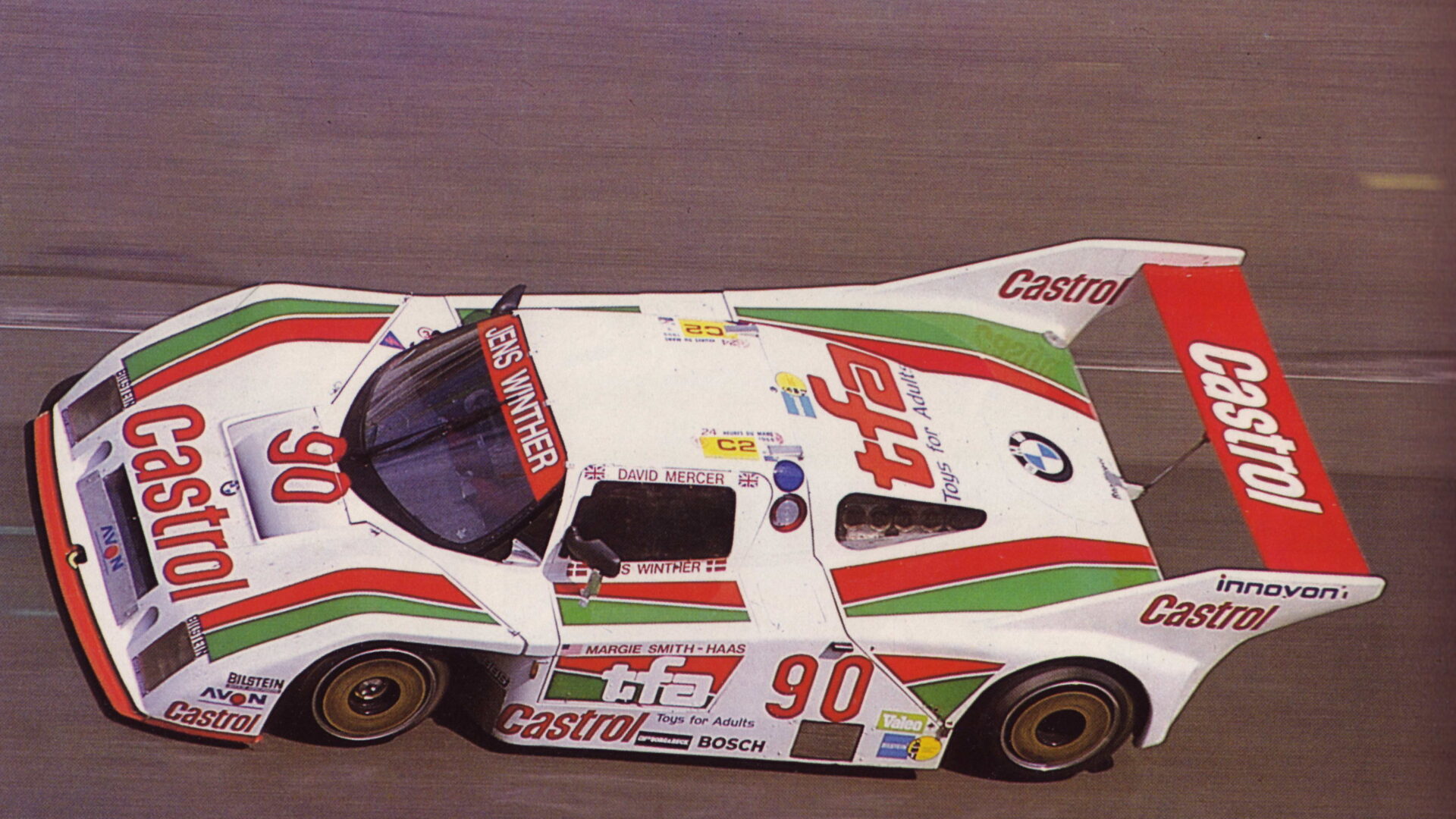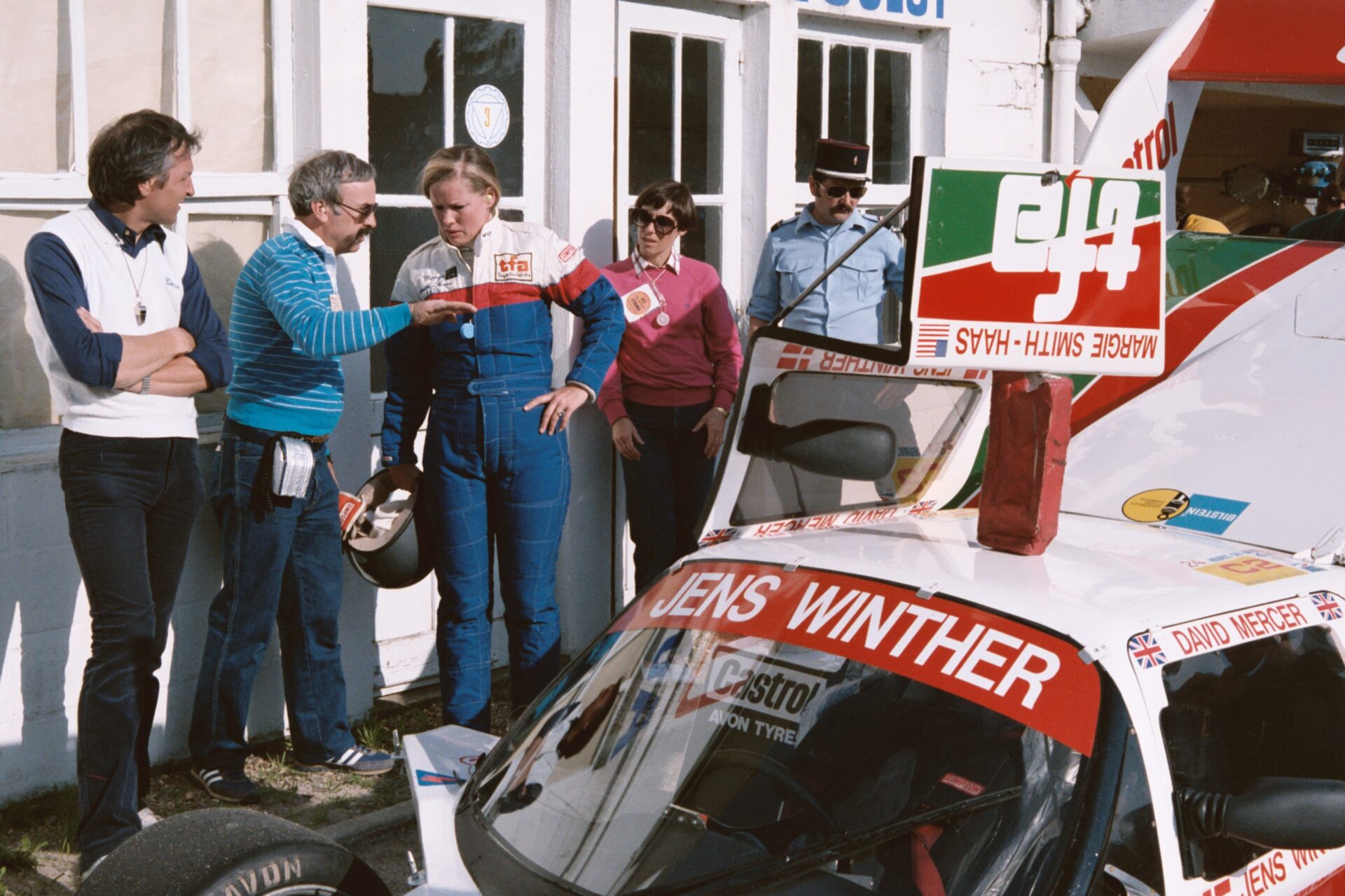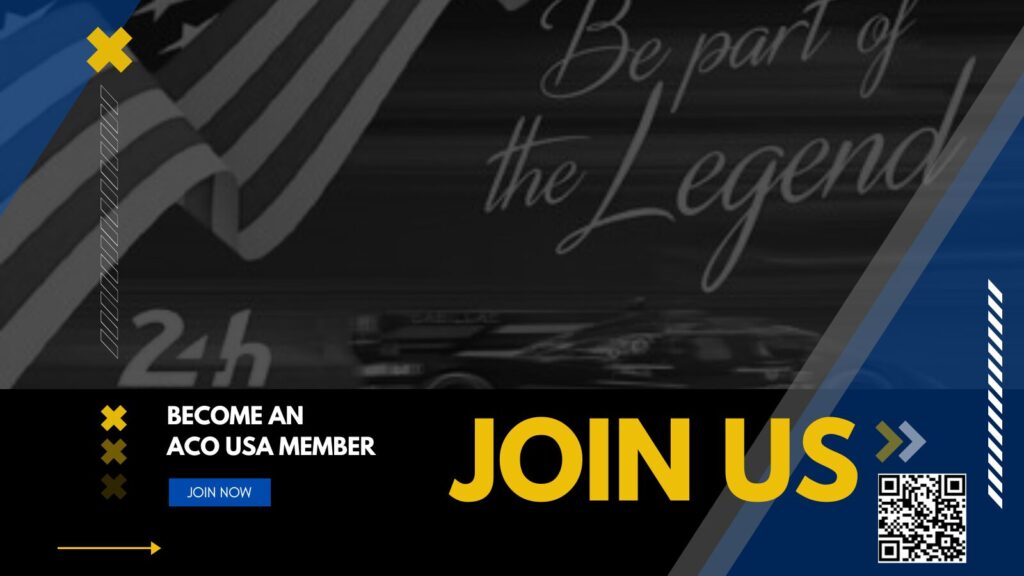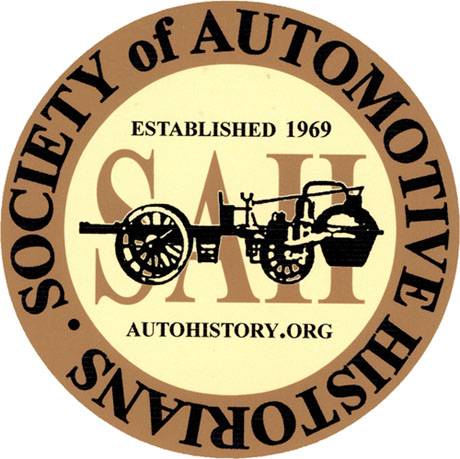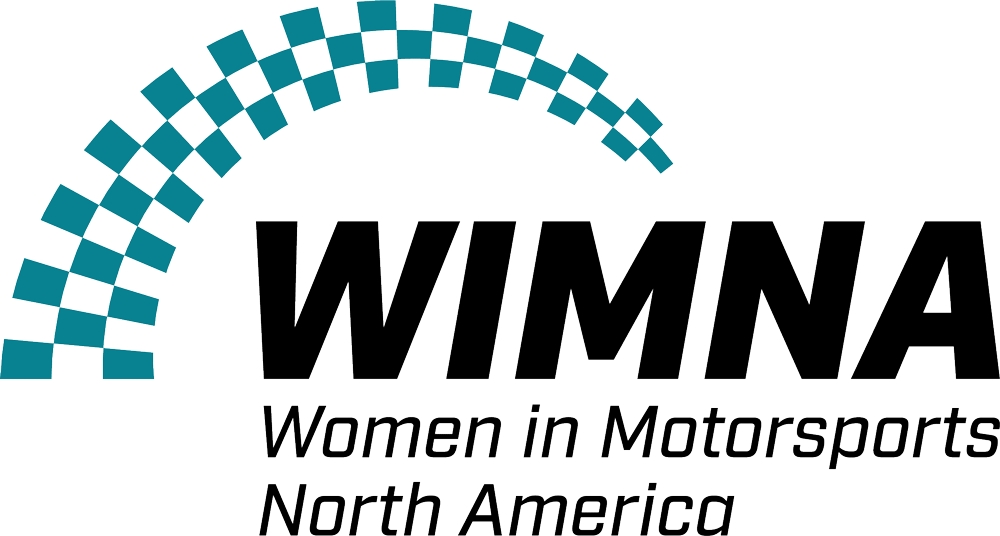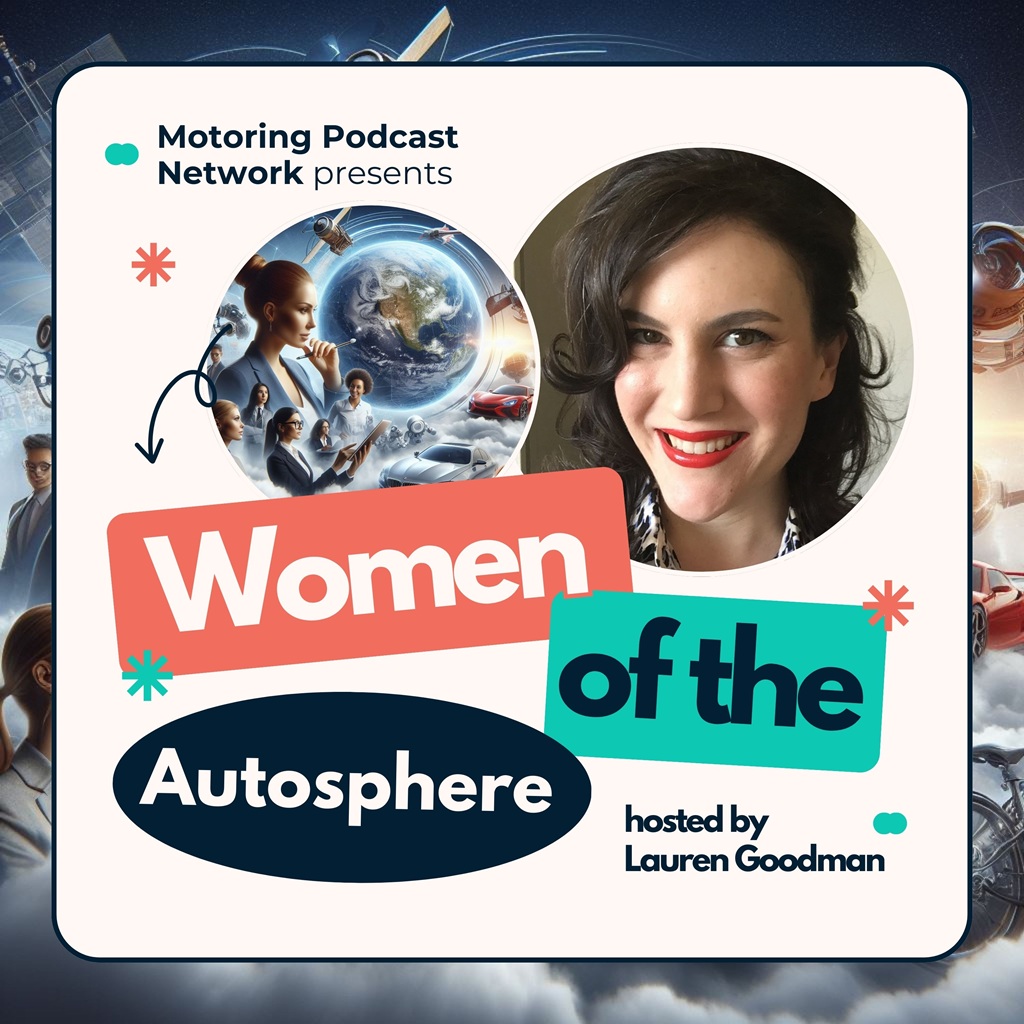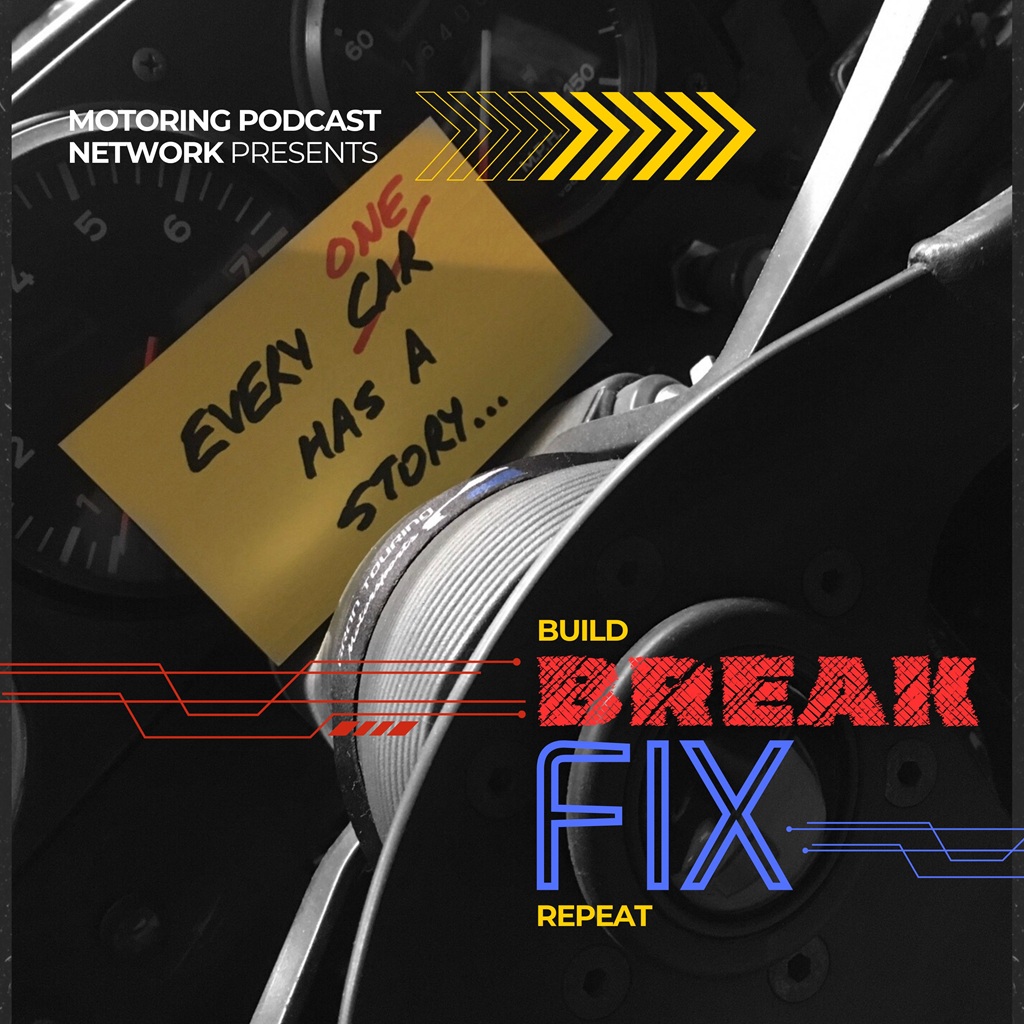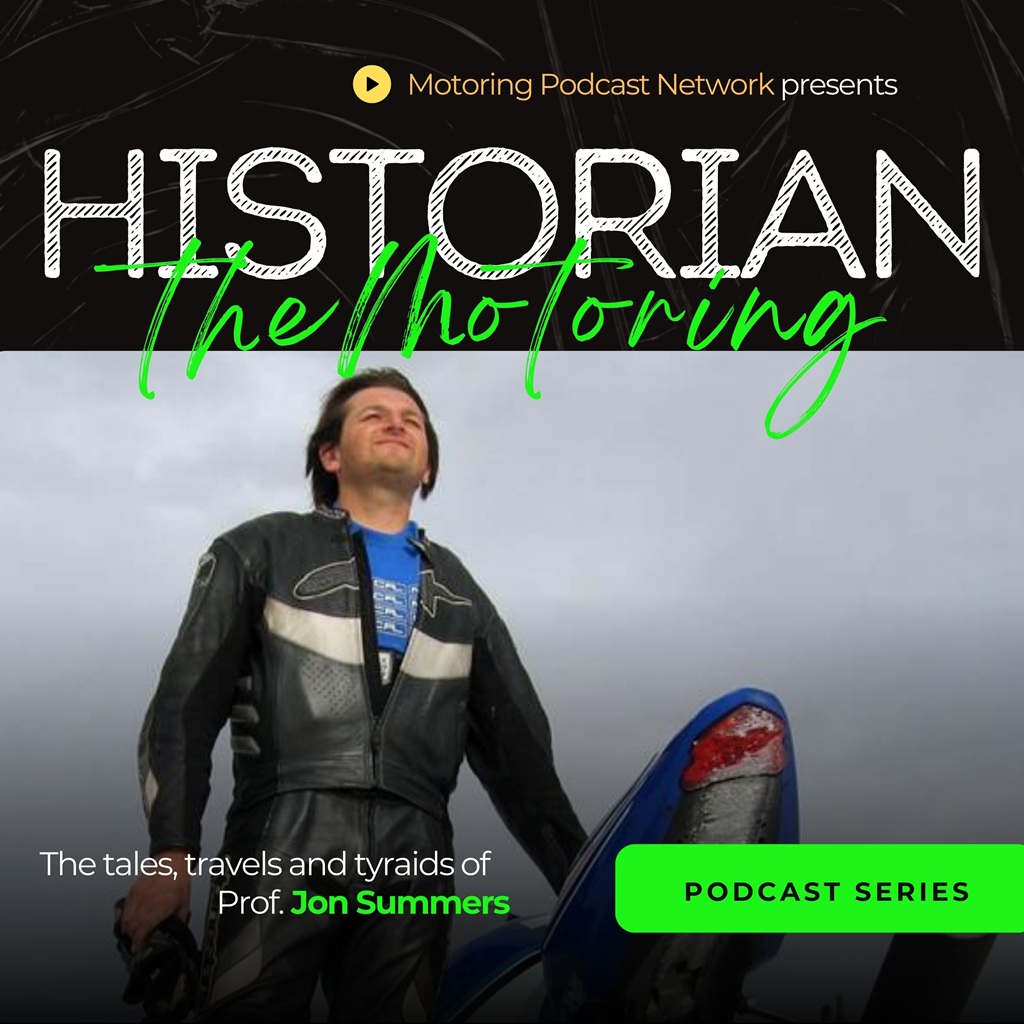Crew Chief Brad: [00:00:00] Evening with a Legend is a series of presentations exclusive to Legends of the Famous 24 Hours of Le Mans, giving us an opportunity to bring a piece of Le Mans to you. By sharing stories and highlights of the big event, you get a chance to become part of the legend of Le Mans, with guests from different eras of over 100 years of racing.
Crew Chief Eric: Tonight, we have an opportunity to bring a piece of Le Mans to you, sharing in the legend of Le Mans with guests from different eras of over 100 years of racing. And as your host, I’m delighted to introduce Margie Smith Haas. She’s a trailblazer in motorsports, renowned for her remarkable contributions to endurance racing, particularly at the iconic 24 Hours of Le Mans.
She was the first American woman to compete in this grueling event [00:01:00] in 1984 and then again in 1985, where she broke barriers while demonstrating exceptional skill, determination, and composure behind the wheel. Her racing performances outside of Le Mans have earned her widespread respect within the racing community, highlighting her as a role model for aspiring drivers.
Balancing both technical expertise with endurance, Margie’s legacy at Le Mans is one of perseverance, professionalism, and passion for the sport. And with that, I’m your host, Crew Chief Eric from the Motoring Podcast Network, welcoming everyone to this evening with a legend. And with that, Margie, welcome to the show.
Nice to be here. Thank you. Well, like all good stories, there’s an origin. So let’s talk about how you got into motorsports. Did you come from a racing family? When did you first turn laps? And let’s also evolve that into your road to Le Mans. How did you get there and how did you put that deal together?
Margie Smith-Haas: My first opportunity racing was in 1972.
When my parents were out of town and I disconnected the odometer on his Buick Electra and took it to the drag races, took [00:02:00] the hubcaps off and stuff. And he never found out about it until 10 years later, whenever I showed him some of the newspaper articles, cause I’d started racing and he said, you little.
I knew you did with that car and I’m like, yeah, dad, but now you can feel responsible because basically the start with the cars, I see the 914 over your head in the back, as you’re aware, we’re enthusiasts for 914 and I bought my first 914, got in Porsche club, did all kinds of their driving stuff. You know, I thought, well, wait a minute, I’m got pretty good talent here.
And, and that’s what got me started and taught me car control and mechanics on the car. As I understand
Crew Chief Eric: it, you started pro racing when you turned 28 years old and your first race was at Road America.
Margie Smith-Haas: That’s correct. In fact, Wayne Baker, who had a 914, had competed with me in some of the Porsche club stuff.
In fact, whenever we went to the 1978 Porsche parade, he let me drive his car. And I ended up taking top time a day for the whole parade till the [00:03:00] last two cars. So I got top time of the day in women. So with how I was showing my skill there, he invited me and my husband to drive at the race at Road America.
Because whenever I was getting my SCCA licenses and stuff, we would pit together with our 914s. So we got to know each other quite well. So you mentioned Paul, your late husband, and you met him through racing. Oh yeah, that’s quite a story. I was a school teacher in Phoenix, Arizona, and Paul lived in San Diego.
And there’s this This track in the middle of nowhere called Holtville in the middle of the desert in California. I saw that there was a, an event there, so I went to the event and we saw each other and my friend introduced us and, you know, we kind of compared our driving thoughts were and our goals were in driving and stuff and we really hit it off.
And so it ended up that we were dating about every 2 weeks. He’d fly to Arizona. I’d fly to San Diego. And then unfortunately, the day after school was out, I had a very bad car accident. I was thrown out of the car. [00:04:00] Luckily, he survived and he came over to help take care of me. And so I ended up having to take a medical leave of absence and ended up moving to San Diego.
We’ve just been an awesome team together because he’s such a coach and so smart in what he does as far as designing cars with aerodynamics and new things. And I think he was quite well respected by our other racers with his designs. So we were married for 43 years. Paul also had a hand in helping
Crew Chief Eric: you get to Le Mans.
So how did all that come together?
Margie Smith-Haas: From that, some SCCA Trans Am. We got a 924 GTR. We didn’t do well in that. Uh, we kept having head gaskets blow, but I’d driven the pro celebrity race at Long Beach, and there I met Dan Gurney. Dan Gurney said, where in the hell have you been? And I’m like, well, I’ve been driving Porsche Club stuff and whatever.
Soon after that pro celebrity race, I got a call from Terry Kargus, and He said, Dan wanted me to drive on his Toyota factory team. And I said, well, who will I be driving with? He said, Gene Hackman. Cause Gene was one of the drivers in the pro celebrity race too. I did well. I came home early from that [00:05:00] race and I get a call at two o’clock in the morning.
And it’s Juergen Barth calling from Germany and I’m saying, Juergen, what, why are you calling me? He says, Oh, Margie. He says, I want to know if you’d like to drive a Kremer CK5 at Monza, Italy in a couple of weeks. And I think the reason I was being invited to do that was because I’d had a. Very successful test in a 935 with Jim Busby.
Perhaps how I did with that and the fact that I’d just done the pro celebrity race and was going to drive for Gurney, maybe that’s why that invitation came. So, so he said, we’d like to know if you’d like to drive a Kramer CK5. And so I nudged Paul and I said, Hey, Paul, Juergen’s calling, wants to know if you want to drive a Kramer CK5.
And he said, tell him yes. And we’ll call him in the morning. So I called Jim Busby right away. And I said, Hey, Jim. I got a call from Jurgen. What the hell is a Krimmer CK5? Should I drive? And he said, yes, yes, yes. You’ll do great. You’ll do great. And if he would like me to drive Le Mans with you as your co driver, I would like to do that.
And I’m like, [00:06:00] wow. And so in result was, you know, Jim said, hey, listen, Margie, you can drive it. You did well with the 935. And, you know, Jim was a big part of the help that I got. And also, you know, obviously my husband, Paul and Wayne Baker, and obviously the Dan Gurney thing is a pretty cool story. I don’t know if we’ll get into that one, but that’s a little feather in my cap.
You know, as I look at my history, I felt that I made the right choice and not driving the 935 after the test, even though I stepped away from driving that. Race, because I didn’t feel I had enough laps in it. Otherwise I would have driven with Jim and Vern Shupin, but I felt it was a good choice to make.
You can really ruin your career if you step into something that’s over your head too fast. So either way, I went to Monza and drove the Kremer CK5. Unfortunately, we had the situation where as we were going down the straightaway, I say, wait, me in the car and I’m going into the hard braking area. Suddenly this tail came out and I backed into the sand pit.
But here comes all of these 956’s [00:07:00] launches and whatever they’re coming right at me. And I’m thinking, oh, this is scary because my feet were not behind the axle. This was a car that the feet were in front. So I thought, oh, I’m going to lose my feet. I didn’t get hit by them. I pulled back out on the track and then I had a slow spin and I pulled out again and it’s slow spin.
So I pulled off the track to find out that I had a hole in the, in the oil cooler. When I got to the pits, I asked Juergen about it and he says. Yeah, I saw the trail of oil going in. You must have gotten into some of the debris from the launches, tires that were exploding and taking out part of the body work and part of that body work went through that oil cooler.
So that was a short race. Didn’t get much time in it, especially since in the early part of that race, Richard Clear, who is the owner from England and Tony drawn, Richard was driving the car and he had the turbos below and there was a two page spread in a forming the one magazine that. Showed that car with the turbos blown.
So we didn’t get hardly any practice in the car [00:08:00] at all, but Juergen was there driving the boss car and, and as I said, Juergen was quite helpful in all of my racing and he helped many of the people that were customers of Porsche set him up with teams and cars, and he’s the one who then set me up for some of the races that were to follow.
With the world endurance championship series and the world endurance championship series centered at Silverstone. And we did not run because the car was overweight. Then the next race that was at Brands Hatch, that’s whenever I was connected with Charles Ivy racing. And a Porsche Group B 930
Crew Chief Eric: Turbo. This all leads up to 1984.
We’re still in the early eighties at this point. So let’s talk about Brands Hatch. Cause this is another stepping stone to how you got with the Charles Ivy team at Le Mans. So let’s keep going.
Margie Smith-Haas: Yeah. And so what happened is there would be some races where Paul would be driving a car in Europe too, and I would be driving the car and we’d be on the same track competing against each other.
It was pretty deep, but sometimes his car would break. And there was one time that they put him in the seat in the car with [00:09:00] me. And Paul Smith, and so they were trying to figure out what was Smith, Smith, Haas, Haas doing on the side door? Like, who are you married to? Or are you with both of these guys? So, either way, what happened at Brands Hatch?
Here, I’m getting to the car. I had never driven a right side drive car. I’d never done left side shift. I’d never driven in the rain and I’d never driven the track. So I’m like thinking I’m real green on this one, but you got to learn somewhere. So Paul Smith went out and he drove the car and he pulls in and we have an electrical fire.
So the electrical fire, they got it out and stuff. And then we just so happened to rain and here I’ve never driven in the rain either. It’s so happens to rain because of the electrical fire, the winter wipers wouldn’t work. I’m like thinking, is there anything else they could throw at me? And they could, and that’s coming.
So I did go out and I was learning the track and stuff. And in the back part of Brands Hatch is whenever you watch for the [00:10:00] 956s and the, you know, obviously the faster cars to come through. And so I was learning the track and then when I was in the back section, I would make sure that I would time their arrival to me so that even if I had to slow down, we wouldn’t be beside each other in the corner because it could end up slowing us both down.
And I’m sure they appreciated that too. And probably was easier on me as I’m going through that turn after they passed. Suddenly there’s just a big puff of like a sound that goes when I’m like, what the hell is that? And then suddenly I’m just starting to feel. Well, I wonder what that was. And I’m sort of like feeling really messed up.
And so, you know, how you see these pixelated pictures where they’ll cover stuff up you don’t want people to see. Well, that’s what everything was looking like. And I thought, Oh, my God, I’ve got two more turns. I got to get back to the pits. Can I find my way back to the pits? So I did. But of course, I arrived early.
And the next driver to get in is like, look at me like, What are you doing here? You know, they opened the door and I said, [00:11:00] I don’t know. I mean, it did really mess me up. And they said, I think we need to get her out of the car. So they got me out. And I think the medics looked at me and said, you can’t drive for, I think another hour or so, but that one, we did get a third place finish.
And was the first race with Charles Ivy Racing. From my reading, Juergen Barth had a lot of respect for Charles Ivy. And as we lead into the story about Le Mans, you know, Charles Ivy Racing had won their class at Le Mans three years in a row. I think that’s why whenever this 1st event at Silverstone didn’t work, considering we got all the way over there, and the car was overweight, didn’t even get to run.
That was a little disturbing. Juergen positioned us with a very reputable team, and I really got along with Paul Smith and David Ovi. So after Monza, I had gone into the Mugello race. We went there and, oh, there must have been eight, they were all white 930s. And I’ve got the video. I’ve got an old video that I looked at.
It’s awesome watching these old, old videos of these cars back in 83, the [00:12:00] 956s and all the old cars. So it ended up that we did well in that race. You know, we just kept our nose clean and we got a third place there. Obviously with endurance racing, you’ve got to go and get fast, but you also got to think smart.
It’s not who’s there at the 23rd hour, it’s who’s there at the 24th hour. The main thing that I wanted to do is prove to the team that I was a reliable driver. I would work up my skills and stuff. But you didn’t want to try to go too fast, too soon and make mistakes. And they were pleased. And then that started moving into them asking me and saying, Hey, listen, I think we should pair up for next year’s 24 Hours at Le Mans.
Crew Chief Eric: Unlike some of the other legends that we’ve had on the program, we’ll use Rick Knoop as an example, or even Rob Dyson, or some of the other folks that have come to talk who didn’t have. A lot of European driving experience before they got to Lamar, they sort of learned it when they showed up and did their practice laps.
Looking at your history, you spent a lot of time at different tracks in Europe. What kind of advice were you given [00:13:00] before going to Lamar? How were you able to practice it? Were there videos available, things like that, where you could study the track?
Margie Smith-Haas: I had nothing that I tell you nowadays, you look at what they got as far as tools to learn.
I mean, whenever I was in racing SCCA or even IMSA, you know, you’d call up your buddies. Hey, hey. Did you get any in car footage with that, you know, VHS tape that you had hooked to your roll bar? Oh yeah, I got some and that’s all you’d have. I mean, I think I had the drawing out of the booklet for what the track looked like at all these races.
I had no coaching, you know, I think we tried to walk the track between the rainstorms and stuff. But you know, one thing that was interesting, I, I remember going into Lamar. I had called Dick Barber. I was past president of Portia Club San Diego region and he was as well. And so I called him and asked him for his advice and he said, okay, here’s what you need to do.
You need to make sure that as if you’re going to notice this as you go down the straightaway, you’re going to see the restaurant on the left. I’m going to say, do I have time to look for the restaurant on the left? And he [00:14:00] said, then you’ll see, you know, and there were people there, you know, suddenly you can, oh, okay, there are people there.
And then he said, look off to the right. There’s a billboard. And whenever you see that billboard, I want you just to lift up and back down on the throttle. So you collapse the boost. So you don’t build up too much boost in the car. Cause you’ve got a long straightaway. And then he said, and then as you go through the kink and you’re going down the straightaway, you’re getting ready to come up and over the hill to break into the malls on corner.
He said. Drag your left foot on the break so that you will be able to heat up the rotors so that otherwise they heat up so fast they crack. So that was a lot of his main advice to me. So we go, you know, try to learn as much the track. In fact, the other day, I think I found. The scribbled sheet where I wrote everything.
Okay. And Dick said something about there’s some woman who’s scantily dressed who’s sitting on top. She’s always on the arm. Co going into Porsche cars. I’m like, do I really care? So, but Dick was [00:15:00] very helpful. I was very honored that he gave me his time to give me information. So I didn’t have any of the.
Audio visual stuff and whatever, you know, you just talk to other drivers and stuff like that. Now, as we got in and I’ll move on on kind of the transition to Lamar, they said, hey, listen, here’s what we need to do. Let’s have you drive the 24 hours of Daytona. So you can see how it’s like to drive a long race.
See how it’s like to drive at night. Do you have vertigo? Do you have problems with lights glaring in your eyes? Cause that’s, what’s going to happen at Le Mans. It’s probably good to know that before you go over to Le Mans. So the end result was I went to Daytona. We had a good team, but you know, there was some things that were not going well, technically or mechanical on the car.
I had mentioned to you that whenever I was a school teacher. I was racing my little Porsche and, you know, doing stuff and getting race tires and stuff, and that costs money. And on a school teacher’s budget, I cannot afford to pay to have all that done. So I learned [00:16:00] how to do my own valves, adjust my own carburetors, take out and rebuild my own carburetors.
Understood what a CV joint looked like, couldn’t get it fixed, so I had to keep going in circles till I could find a way to get into my driveway because I couldn’t turn the other direction. That was interesting. And then the other thing was I had at one stage, whenever I was driving the car, I had the throttle stick to the floor whenever I was taking the off ramp in Phoenix.
And so I knew that, you know, hey, to stamp that pedal and it popped up. Well, it’s a good thing I had some of this. Experience, because when I got to Daytona, I had to rely on it and I had to be able to give that feedback to the crew. I think a lot of more women drivers are doing it, being able to give feedback and understand the mechanics of the car and stuff, understanding the physics of the car, what it’s doing and how you can give feedback.
So they can best set the car up for your next session. So what happened at Daytona, they got into the car and the first session or a few times out. You know, you’ll go up in the banking and the banking is so steep. It [00:17:00] really, really is murder on CV joints. And so then when you come down in the back straight and you take the school bus turn, and then as you’re coming out of the school bus, you go to go back up on the banking.
Well, as I was coming out of the school bus turn, I noticed that I started to get a slipping. In other words, like the tranny was slipping. I thought, Oh my God, I’ve got a CV joint going. And I thought, if I can’t get this car back to the pits. We’re out of the race. So I’m thinking school teacher. Here we go.
And so what I did is I would jerk the car drastically back and forth trying to get 1 of those little balls to drop back into that mouse trap. So it would sort of start catching and it did catch and I was able to get the car into the pits. And they got that changed. So that was good. But then the next problem reared its ugly head.
My next step, when I got into the car, I pressed the accelerator full throttle and the straightaway coming out of the hot pits and the throttle stuck to the floor. And I’m like, Oh my God. So [00:18:00] obviously you don’t push the clutch in because you’re losing the engine. So I needed to shut the engine off. And then I started stamping my foot on the pedal, knowing I had had this happen with my 914.
Finally got it to come up. I went and I got went back in the pits and I pulled it. I said, hey, guys, the throttle sticking down. And I said, it’s right here under here. There’s this little hammer looks like a little toggle type thing. I said, I think it’s bent because I’ve had it happen in my car. And they said, Oh, no, no, no.
They kept working on the back and I, and what they said they were working on slide valve injection or something like that. I’m like, okay, no, they sent me back out and I did it again. And I came in and I said, listen, guys, you got to get this fixed because otherwise, you know, somebody is going to get hurt here and I don’t want to put this car in a wall and I definitely don’t want to get hurt and I’d like to finish this race.
And so they still kept saying slide valve injection in the back or whatever they called it. Paul comes in the window and said, Hey, Paul. Go get a rope. So we get a rope. We tie it to the pedal. We take it up to the roll [00:19:00] bar, ride it around the roll bar. So now I have like my giddy up. Whoa, whoa. So it’s like, I go out.
They said they had it fixed. It still got stuck. And I just pull that up. I had to drive the rest of my leg saying giddy up and whoa. So whenever I gave the car over to the next guy, I think his last name was Zuzelka, so I gave the car to him and he goes out and does one lap and he comes in and he was white as a ghost.
And he said, you either fix it. Or I ain’t driving it. Guess what? They fixed it. They unhooked the rope and they put in the part that was bent underneath the throttle. So sometimes, you know, being a woman in racing, they probably don’t believe what you have to say. And I could have saved him a lot of time, but that’s a hell of a story.
And we ended up finishing. Sixth in GTO
Crew Chief Eric: and maybe a lot of people don’t know. And we preface this episode talking about how you were the first American woman to run the 24 hours in Le Mans.
Margie Smith-Haas: Yeah, there were other women who drove the 24 hours of Daytona. I was the first to drive both of them because obviously, you know, and other people had driven it and done quite [00:20:00] well, but somebody said, well, you’re also, if you’re the first to do Le Mans, you also got to be the first to do both of that ties in well with the story of Le Mans, because.
It was a good testing ground. I’m glad we finished 6th in GTO.
Crew Chief Eric: So that springboards us into 1984. You’re with the Charles Ivey team in the 934, the burgundy 911 that you see in the pictures that’ll be in the follow on article and on the Facebook group. And so you get to Le Mans and you had already been to Monza, you’d been to Silverstone, you’d been to Mugello, you’d been to all these other places.
But Lamar is different. It has a different character. It is a different personality. It just greets the drivers differently. The whole thing is a circus in some respects. So tell us about your first impressions being there in 84 new car, new team, all these kinds of things. What did you take away from those first moments at Lamar?
Margie Smith-Haas: Well, it was almost like the whole welcome thing. You know, it’s. The track and part of the track is the area of the country. The people, the churches, the restaurants. Oh my God. The restaurants were great. If you had time to eat, but one thing that was cool. When we first got [00:21:00] there, the Porsche factory had boycotted in 1984.
They did not run in 84. And so what happened was, because the Portia family didn’t come, the lady who was with the public relations with Portia, Ilse Nadely, I think she was also a secretary to Husky von Honstein. So she said, well, Margie, we got you set up in the Chateau Vaudreuil. And that’s the one that the Porsche family stayed in.
So that was cool. So that’s my first thing, okay. And I’m thinking, wow, this is a cool start. Now let’s get out to the track and stuff. You step into the track and, because it was the old track, front straightaway looked a whole lot different. We’re talking the garages were quite old and in the back walkway, it was just a gravel thing and you needed to change your driver’s suit.
It was like, okay, guys, go for it. But this ain’t working for me. So I was having to go to the restroom and stuff. You know, you’d look up and then all the crowd will be up in the grandstands over you just going over the scene, the, the Ferris wheel and stuff that you’d heard about and whatever, and [00:22:00] just the old towns.
And then at the end of the malls on straight, the old buildings that are, you know, the town of malls on, you know, we didn’t have the canes in the back. Straight. We just had the kink, which I’m glad I got to experience the kink. It was definitely one of those pucker factors. Sort of like road America. Yeah.
Yeah. Once you did it, you better do it the same way next time. So the team was there and the unfortunate thing that happened. And I didn’t find this out really notice it that much. Cause I so focused on the track and stuff like that was that Charles Ivan was great, but here he’d won three races in a row.
And so they had a shirt printed out that said, let’s make it four and 84. That would have been absolutely awesome because, you know, I would have been a female that was winning. Of course, you know, there’s other awesome female drivers that I had met that weren’t driving that Le Mans. So one thing that happened back to Charles Ivy.
They had done so well in three races. And unfortunately, what did happen in this particular race, they entered too many cars, in fact, none of them finished. [00:23:00] It was unfortunate because Paul Smith said, he said, I think we could have had the opportunity to win, but also the car wasn’t running. Well, as he had said to me, it was overheating.
The oil was hydraulicking from what he was saying. So that was creating problems. So that led us into, you know, we did the practices. We tried to save the car. So we had plenty for the race. Then it was time for qualifying, and I had not qualified yet. Of course, they said every lap is really qualifying, I guess, but I was still way learning the track.
I had not been to the track before, and they had, and it’s not an easy track to learn. It’s a long one. I hadn’t turned a time that was quick enough yet, because you had to do a certain percentage of the number of cars, and that percentage kept getting higher because the faster cars were out there, and they’re moving the bars, so that meant the lower cars.
Had to move the bar too, because obviously we were the last few cars on the grid, the cars and the car was regularly a group B car, but they did make a and Paul said that by doing so, they were trying to take [00:24:00] advantage of certain things and lighter here and whatever. But there were some parts of the rules that they did not take advantage of that.
They could have done when it came to qualifying here. They’ve turned their times. And now it’s getting into the night and I need to turn a time that is fast enough. And I had not gone through the kink flat out yet. So they said, okay, we’re going to send you out and you do four laps. Well, the thing is you’re doing four laps, but those are long laps.
You’re not getting to learn a whole lot of the track. There’s a lot of stuff happening in between. So I come in and I think it was Peter Twitchen, I think, uh, was the crew chief’s name. And he said, tell me in his English accent. Well, how’s it going out there? You got more in the car? And I said, I think I’ve got lots.
And he says, well, can you give it to us now? Please? He even said, please. And Paul Smith was just, I guess he was beside himself. And I went out. And right after I left, after I’d gone by the first time, 10 seconds [00:25:00] later, they dropped the white flag. It wasn’t my last lap. I got to do one more flying lap. And on that last lap.
I knocked off 8 seconds because I said to myself, I’m going through that kink and I’m just going to keep that pedal down flat out and I’m going to come out on the other side. And hopefully it’s with all 4 wheels on the ground. I have got to knock a high amount of time off and I did. And I guess the crew is going nuts.
And so that was nice. So we did qualify the car, but we still had the overheating problems. So, during the course of the night, whenever I did my one leg, this was just before dusk, and I’m going down the Molson Strait, and I can see, you imagine this is a little traumatic for me to see the 1st time. Here’s cars burning.
The forest is on fire and there’s a driver laying in the road. And I’m going through the smoke and there was a car in front of me. I needed to make sure I didn’t hit him. Apparently, when we came around, you know, the ambulances were there and they were, John Sheldon and the Aston Martin and Drake Olson had come together.
One got into the [00:26:00] Armco and then bounced off and collected the other one. And John was burnt very badly. He did return the next year and drive. But unfortunately, one corner worker was killed and another one hurt badly. We were under almost an hour of yellow flag, but I watched my 1984 video of that race and the um, person who was behind the Pace car was saying, I cannot believe they haven’t red flagged this race, you know, and then put people back out.
So that was a little bit of a scary thing. So we drove through the night and I got out of the car and take a little rest in the Volkswagen when I came back to the pits for my next leg. The car was parked there with a puddle of oil under it, because he said something about the chain had broken through and busted.
I don’t know. So the car was out and, you know, he did say he felt that we would have done better had it not been for having too many cars entered in the race.
Crew Chief Eric: It was a disappointing finish in 84. You weren’t to be stopped in any way. This wasn’t the end of your racing career by any stretch of the imagination.
Margie Smith-Haas: I was looking at the video and [00:27:00] so they were interviewing Brian Redman and Brian said. I’ve driven this bloody race 10 times, and I’ve yet to finish. A lot of people, if you look at DNFs and whatever, need to understand when it’s a 24 hour race, there’s a lot of DNFs that happen, and, and you’re lucky if you’re one that gets through.
In fact, it’s amazing how many people will win Le Mans or be in the top three, that during the course of the night, with all their mechanical issues, you would have bet, you know, your life on it, that they’re not going to win the race or be in the top three. 1984,
Crew Chief Eric: you get to the end. of this event. Had you realized at that point that you were the first American woman to compete at Le Mans?
Did that hit you at any point when you were there?
Margie Smith-Haas: No, I did know I was the only woman in 84 and 85. You know, I was getting a lot of stares. I mean, it was like, even though there were other women drivers there and I, that’s whenever I did meet Charlotte Vernet, a lovely lady. So what happened was it came to 2013.
I ran it in 1984, now it’s 2013, and the man who [00:28:00] purchased the car that I drove in 1985, that was driven by Jens Venter, the Danish guy, he has a phenomenal auto museum. And in fact, he’s so close with Christensen that whenever that car comes off the track after winning Le Mans, it goes on a trailer with all the dirt on it and goes to his museum.
Just amazing museum. So, what happened was, he had bought the car. And he was going to have a promotional thing at the museum, and he brought David Ovey from England over, myself, and that was also Jens Venter from Denmark. He had us as the special guests. Whenever they were doing the press release about it, I get a call from the journalist, and he said, and I thought it was very nice.
It’s be nice if people would sometimes check if the press release is accurate. He had something in it and I said, wait, wait, hold, hold, hold it. What’s this? This is saying I was the first American woman to drive the 24 hours of Le Mans. Huh? He says, yeah, well, you were looking Wikipedia and see, I haven’t done any Wikipedia [00:29:00] stuff and whatever.
I haven’t, not a lot of my racing out there. In fact, I probably, people say you need to do something because people would like to know some of the history, even though it’s not always the best record, but you’re a pioneer. That was pretty surprising to me. But that was the first time. So 29 years later, I find out.
Because you know what? I was not driving to be the first at anything. I was driving because I love to compete and I wanted to win. And admittedly, you’ve got to pay your dues to win. So that was quite a surprise for me.
Crew Chief Eric: You had a second attempt at Lamar. Following year in 1985. And what’s interesting is if you look at your racing career, you really leapfrogged cars going from a nine 14, six to the nine 34.
And then you make this big jump into group C2 running the URD BMW. So totally different team, totally different car. If you look at the group C2 cars. They’re sort of the beginning of what we consider today, the prototype classes. What was it like taking the jump from a production car to basically a prototype?
What did [00:30:00] 85 teach you? How did that all work out for you in comparison to the year before?
Margie Smith-Haas: Well, I got more track time in 84. We lasted longer. The BMW was an extremely, extremely awesome car. In my discussions with David Mercer, he had mentioned that the car had no rev limiter. And it also had a very light and flywheel.
I had, uh, over revved, you know, I hadn’t blown an engine before. And after this all happened, because I was the person who, unfortunately, that happened while under my watch. Why they weren’t putting in a rev limiter. Couldn’t quite understand that. The car had its quirks and stuff and he said he’d driven it several times.
And there was a lot of stuff that he had to learn about the car that he already knew. And unfortunately, I had to witness and I made the mistake. And I have to admit, it’s really embarrassing. But I sit there thinking, well, look at all the other DNFs. I’m sure other people have had engines go, but it was unfortunate.
It was at such a phenomenal race. And a few years later, I talked to, uh, [00:31:00] Jens Venter, and he said that they really enjoyed driving with me and that he would have liked to see us drive some more. In fact, I’m trying to think that car had not finished any race over a thousand kilometers. But it was a beautiful car.
And I think it’s still at the museum. I really enjoyed driving it. It’s just unfortunate.
Crew Chief Eric: As a high aero, basically a ground effects car compared to the 911. Was it easier to drive?
Margie Smith-Haas: Oh, it was awesome. It was awesome. And it was like a slot car. I didn’t get to really experience it with the Kramer CK5 because that was a C1 car too, but we didn’t get hardly any time in that car.
In fact, one person said that I didn’t turn any laps at all and contacted Juergen. I said, was I not there? He said, yeah, you turned laps there. So the one thing about the URD. Was that the ground effects was something that you needed to work up to it. So you trust the car. And I think I mentioned to you with my American city racing league experience, even though, you know, that’s after the Lamar stuff.
And I went in and I won that championship, which I really, I’m still [00:32:00] just in awe that I was able to do that. I wish if I had it to do over again, that car taught me so much about aerodynamics. Cause I felt like I was part of the car. I didn’t feel like I was a driver getting in and driving the car. I felt like my body was part of it.
I probably would have had had a faster learning curve had I had more experience in an aerodynamic car. But still sometimes you got to take what you can. It was unfortunate that I didn’t make it at the second 24 hour race. But you know what? It’s just like Brian Redmond said, I’ve driven it how many times?
I still haven’t bloody finished. So I’m like thinking, Brian, thank you for your quote, because it really helps people understand what is going on
Crew Chief Eric: here. So was there an opportunity to run again 86 or later? Had you made a decision to just give up on endurance racing altogether? I mean, you already. Implied that you went to ACRL.
So what made you make that transition?
Margie Smith-Haas: Paul wanted to be in charge. We had a three car team and just the design of the car and stuff. We did invest [00:33:00] in Swift. We’re one of the helped invest in Swift and he just loved the cars and. We would go to races and he would do things to these cars that you’ve probably seen it.
We were called the Batmobile everything. We’d show up at the races and people look and say, look at that front nose. My God, look at that elongated tail and everything all done within the rules. You know, when we’d show up, we’d put a cover on it. Doesn’t you know how they cover all their stuff? So Paul would do that.
On the sports 2000 in the next week, everybody’d come with a nose or something that looked like Paul’s because they wanted to know what’s he got up his sleeve this week. And our car, whenever I won the championship in that car, it was the heaviest and oldest car in the grid. But what made it really work was the aerodynamics.
And the other thing too, he was a wonderful coach. He was so well learned in what he was doing. When I won that championship, he had cancer the first part of that year. The first two races, I was in second place by two tenths of a second. And so whenever he told me he had cancer, I said, well, I’m hanging up my helmet.
He says, no, no, no, no, no. He said, I know [00:34:00] this is your year. I’d have to help drive the rig and get the rig up to the races, and then another crew member would fly him in. So I ended up setting a pole, and then I went to Vancouver, and here I was in my Valvoline suit with the Say No to Drugs program. Robbie Gordon was also with Valvoline.
I had set the pole at the race before, and they said the only reason I set the pole was because the guy who usually ran first, Peter, was at a wedding. I sort of took that as a little bit of an insult, but I also realized when I get to that race, I could also push myself. I’ve thought smart. I’ve always put pressure on the person in front of me.
So if I can always finish second and make sure I put pressure on the person in front of me that they make a mistake, I’ve got this thing. So when we went to Vancouver, I thought, well, okay, Walls, I better just step it back. Don’t try to get the pole, just finish. But that was just sort of a different feeling than what I’d had through the whole season.
So when I walked out, just before we pulled out to go for qualifying, I still. Looked at everybody and I pointed my finger and I just [00:35:00] thought I can beat you, you, you, you, you. I got in the car. I went out. I thought that I wasn’t pushing it. Lo and behold, I got the pole. So that two pole points, I didn’t find out until after we finished the race.
I finished second. Scorekeeper called me in the car on the way home from the track and said, Margie, I am so sorry. I forgot to add the pole points in. You’ve clinched the championship by one point. And you don’t have to go to the next race. So Robbie and I, both of us, set the pole at Vancouver for Valvoline.
So that’s pretty cool. And so at the banquet, I dedicated the championship to Paul in tears,
Crew Chief Eric: and I couldn’t have done it without him. For those keeping track at home, that’s yet another first for you, Margie. You’re the first woman in North America to win a professional road racing championship.
Margie Smith-Haas: Yes, and you know how I found out about that?
I, I was just so glad that, you know, I did well. I get a call from The Meister, Chris Economackie, and he says, Margie, he says, I want to congratulate you. Do you realize you just became the first woman in North America to win a professional road racing championship? [00:36:00] What comes all around here is going from my little 914 slaloms, autocrosses.
Time trials, SCCA, the first American woman, I had no plans to be a race car driver. I was a school teacher, but I’ve enjoyed the challenge of it. And I’ve taken on not only the challenge of the driving, but of the educational process of understanding how the car works, the physics of the car, lift throttle, oversteer, kicking the tail out, dragging the left foot brake and stuff.
That all comes with experience. I didn’t expect as a PE teacher and coach that would happen. But you know what? When I graduated from college in 1972 is when they passed Roe versus Wade. And I did not have sports that I could compete in whenever I was in high school or college. Now I had a sport I could compete in and I did quite well in it.
All I know is that whenever I was in sixth grade, I did the softball throw and I had the city record. That’s the only thing. That was it. But it’s [00:37:00] such an honor. It’s unbelievable. And it wouldn’t have happened without. Paul and I owe everything I’ve had happen for me and him.
Crew Chief Eric: So many of the legends that come on here, we like to ask them about challenging parts of Lamont’s and the conditions and things like that.
But the bigger takeaway generally is that Lamont changed them. as a driver, mostly for the better. They thought they knew until they got to Lamar and Lamar tends to, let’s say, break the Mustang to use that pun. Right. What do you think Lamar taught you? How did it change you as a driver? Ultimately it brought you to that championship in the ACRL, but what did you take away from Lamar?
Margie Smith-Haas: You realize stuff happens no matter how prepared you can be. There’s things that are out of your control, but I think what I took away from it was goal setting. In other words, you don’t have to be unrealistic and think that you couldn’t win Le Mans, but it’s not an easy task, and it takes a way to get there in certain combinations of car, driver, crew, but I would say I learned major respect [00:38:00] for a long race.
I learned the appreciation of the history of the race and the history of the drivers. You know, when I ran those races over in Europe, I was just amazed at seeing the other cars and meeting other drivers and most of whom we didn’t speak the same language, but it was thrilling. It was really thrilling. I did hopscotch, leap a little head on some stuff, but sometimes You know, when the opportunity comes, you need to take it, but sometimes you don’t take it.
I didn’t take it in the, in the 935, but I did take it at both Le Mans. And I’m still glad I did because there’s a whole lot of other people that had the same thing happen, and they eventually won it or are still looking for that win. I won’t reach that. I’m a little too old now.
Crew Chief Eric: So as we wrap up here in our final segment, I’m actually going to incorporate one of the questions from our crowd into this next idea that we have here.
So you’ve returned to Le Mans many times after your 1984 and 1985 attempts, and I met you there at the 100th in 2023 [00:39:00] as we were celebrating that. You’ve seen a lot of change in the last 40 years. Oh my God. There’s a lot of good that has come. To Lamont and May Lee starts out by saying, thank you for being a trailblazer, but she wants to know, how do we increase the number of females and such a male dominated field?
And it reminds me of a story you were telling me about meeting the iron dames. So let’s talk about. Modern Lamar and what this all means and how you kind of open the doors for a future generation of drivers
Margie Smith-Haas: When I went to Lamar and David took me up to meet the Iron Doms I was just going nuts because I I was so excited about him I haven’t gotten to follow and be a supporter of women through this whole time because I’ve you know been dealing with you know, my business and Paul and so I didn’t get to really follow it through but I’d heard about them and it was just great to be able to meet them, but was so bizarre.
And I was so surprised at this. I walked over and I had a picture of the car that I drove at Le Mans, so I could give them the picture. So I could say, this is what it is now. This is [00:40:00] what it was then. David was introducing me. The one says, Oh my God, it’s you. And I’m like, how do you know me? She said, you’re the first woman from the United States who drove Le Mans.
Well, maybe David must have told him that or whatever, but either way, I was so shocked because I was receiving such a warm reception from them when it was them that I felt, you know, hey, you guys are the show here now and best of luck. Let’s pass the time and keep passing it so that we can. See a woman, hopefully win Le Mans.
I really was blown away when I got to meet Christine Beckers from Belgium. She had driven Le Mans four times in the seventies and she and I hit it off. And then the other thing, while I was there at the, uh, dinner at the end of the Malzahn Strait for the Club de Pelote members, I spent a long time talking with Charlotte Vernet.
She’s, I think, driven Le Mans the most times. And they’ve got quite a stable of women drivers from Europe, but we’ve only had four women from the United States drive the 24 Hours of Le Mans. We need to [00:41:00] see that change. If that’s the ultimate star in the sky, let’s start going for it.
Crew Chief Eric: We have women who do.
You were also featured in a film in the last couple of years that was done by Porsche, alongside of Sabre Cook. So what was that all about? Is that also trying to help promote women in racing and get more eyes on Le Mans?
Margie Smith-Haas: Yeah, well, actually, whenever I was in Australia last year, I got an email and it was from the ad agency for Porsche.
And they said, we’re doing this video and we want you. To be in it and it’s based around women’s achievement month, the month of March, which is sort of what we’re doing with some of this and that’s why they did it. And I’m sitting here thinking, well, you know, it’s really honored. Obviously I’ve dedicated a lot of my life with Porsche.
I’ve been a member for over 50 years. I’m a member in West Australia as well. So they called and I have to admit, I had to get over jet lag from. Australia. They put it off by a day because, you know, I needed to, I needed to at least get myself some sleep. And I met Sabra. What an amazing gal. [00:42:00] And so they were doing it to show the legacy of me as a legend and her as the upcoming person.
And what was amazing about it is whenever we took that video, she’s the same age I was whenever I started racing professionally, 28. And 1994 is when I won my championship, and then it was a situation where she was now competing. And so the new blood, so I was the grandma, you might say, which it’s hard to say this, but I could be her grandmother, but we hit it off.
And I was just so impressed with her and her being mechanical engineer and stuff. So it was nice that Portia did that. I was really flattered because like I said, as a school teacher, I didn’t expect to do all this.
Crew Chief Eric: Margie, if you could go back to Lamont today, behind the wheel of a race car, drive any of the cars from the 2023 season, the 2024 season, what would it be?
Would it be the 963? Or is there something else that gets you excited?
Margie Smith-Haas: No, I sort of liked the Porsche. I mean, it’s. I’ve been [00:43:00] a real follower and all my sports cars have been Porsches. And I just, I just think that, um, it would be such a different car. I mean, if you thought that cars were probably challenging before, I imagine with these ground effects are more challenging, but there’s also so much more technical stuff in it that’s keeping you from making mistakes with the car.
So the cars are kind of helping drive them. So I have to admit, I love jumping in my 914 6. And just driving it, and just a stick shift, no air conditioning. But boy, did I come a long way from there, didn’t I? Wish I could have gone further, but I guess winning a championship isn’t bad.
Crew Chief Eric: Nothing wrong with that.
So on that note, I’m gonna pass the baton to David Lowe for some final thoughts as we wrap out this evening with a legend.
David Lowe: Margie. On behalf of all the ACO USA members and also the ACO, thank you so much for giving your time and sharing your exciting, thrilling adventures with us this evening. Thank you.
Margie Smith-Haas: Well, you’re welcome, and I also want to thank you at the bottom of my heart for giving me the [00:44:00] opportunity to go to Le Mans in 2023, help introduce me and take me around. That was great, and hopefully I’ll be able to get back again. I had hoped to go last year because it was the anniversary when I drove, but the ACO USA is a great group, ACO is great, and it’s an honor to be part of your group.
Crew Chief Eric: Thank you again, Margie. Thank you so much. And on behalf of everyone here and those listening at home, thank you, Margie, for sharing your stories with us. Margie Smith Haas made history as the first American woman to race at the legendary 24 Hours of Le Mans, paving the way for future generations of women in motorsports.
Her groundbreaking achievement was more than just a personal milestone. It was a defining moment that challenged norms and highlighted the importance of diversity and inclusion in our sport. Competing on the world’s most demanding endurance racing stage twice, Margie demonstrated exceptional skill, determination, and resilience, proving that talent knows no boundaries.
And her legacy continues to inspire drivers worldwide, cementing her place [00:45:00] as a true pioneer in the storied history of Le Mans. And we hope you enjoyed this presentation and look forward to more evening with the legend throughout the season. And with that, Margie, I can’t thank you enough for coming on and dialing in from West Australia early in the morning to talk to us and share your stories about Lamaze.
So we look forward to seeing you again later this season and many seasons to come. And so thank you for everything you’ve done.
Margie Smith-Haas: And thank you. You’ve been a wonderful person doing the interview and you’ve guided me along the way been very patient and it’s an honor to be part of the group and be on your program.
Crew Chief Eric: This episode has been brought to you by the Automobile Club of the West and the ACO USA. From the awe inspiring speed demons that have graced the track to the courageous drivers who have pushed the limits of endurance, the 24 Hours of Le Mans is an automotive spectacle like no other. For over a century, the 24 [00:46:00] Hours of Le Mans has urged manufacturers to innovate for the benefit of future motorists, and it’s a celebration of the relentless pursuit of speed and excellence in the world of motorsports.
To learn more about or to become a member of the ACO USA, look no further than www. lemans. org, click on English in the upper right corner, and then click on the ACO Members tab for club offers. Once you’ve become a member, you can follow all the action on the Facebook group ACO USA Members Club and become part of the legend with future Evening with the Legend meetups.
This episode has been brought to you by Grand Touring Motorsports as part of our motoring podcast network. For more episodes like this, tune in each week for more exciting and educational content from organizations like the Exotic Car Marketplace, The Motoring Historian, Brake Fix, and many others. If you’d like to support Grand Touring Motorsports and the [00:47:00] Motoring Podcast Network, sign up for one of our many sponsorship tiers at www.patreon. com forward slash GT Motorsports. Please note that the content, opinions, and materials presented and expressed in this episode are those of its creator. And this episode has been published with their consent. If you have any inquiries about this program, please contact the creators of this episode via email or social media, as mentioned in the episode.
